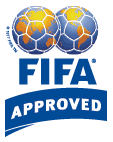FIFA Soccer Ball Test
FIFA Approved and FIFA Inspected
FIFA soccer ball test was developed by
good guess
FIFA, to guarantee the highest standard and quality of soccer balls. It's actually called: FIFA Quality Concept for Footballs.
 The test is conducted by examining seven different characteristics of a soccer ball: Circumference, Permanent Roundness (Sphericity), Water Absorption, Weight, Uniform Rebound, Loss of Pressure, Shape and Size Retention.
The test is conducted by examining seven different characteristics of a soccer ball: Circumference, Permanent Roundness (Sphericity), Water Absorption, Weight, Uniform Rebound, Loss of Pressure, Shape and Size Retention.

Only after passing the specific standards of all these components, the ball is awarded the highest quality mark "FIFA Approved". Soccer ball test for FIFA Approved emblem is only performed on size 5 balls.
The balls matching less rigorous criteria might receive the "FIFA Inspected" hallmark. They are not tested for shape and size retention, however this soccer ball test includes also balls size 4.
FIFA Soccer Ball Test - Quality Concept for Footballs
Circumference test
A consistent circumference is important to allow optimal control during dribbling or driving a football. In order to calculate the average circumference, each individual match ball is measured at 10 different points.
| FIFA Approved Standard |
68.5 cm - 69.5 cm |
| FIFA Inspected Standard |
68.0 cm - 70.0 cm |
Size 5 |
| |
63.5 cm - 66.0 cm |
Size 4 |
Permanent Roundness test
Only a perfectly round ball allows a player to fully capitalize on his skills. The more perfect the sphere is, the more balanced a ball will be in flight, the higher will be its accuracy and the predictability of its flight.
The diameter of the ball is measured in 16 different places, after which the average is calculated. The difference between the highest and the lowest diameter must be within very strict limits.
| FIFA Approved Standard |
max. 1.5% difference |
| FIFA Inspected Standard |
max. 2.0 % difference |
Size 5 |
| |
max. 2.0 % difference |
Size 4 |
Water Absorption test
A wet and heavy ball behaves quite differently from a dry one. It flies through the air more slowly, has a low bounce and is more difficult to curl.
For the water absorption test, the ball is pressed and rotated in a container of water 250 times, after which the ball will be weighed. The water will also be weighed before and after the water uptake test.
| FIFA Approved Standard |
no more than 10% weight increase |
| FIFA Inspected Standard |
no more than 15% weight increase |
Size 5 |
| |
no more than 15% weight increase |
Size 4 |
Weight test
Each professional game is played with a number of balls. These different balls all need to perform the same. Consistency in weight is crucial. If the ball is too light or too heavy, it might move unexpectedly in flight.
| FIFA Approved Standard |
between 420 - 445 grams |
| FIFA Inspected Standard |
between 410 - 450 grams |
Size 5 |
| |
between 350 - 390 grams |
Size 4 |
Uniform Rebound test
Players need to be able to anticipate how the ball will respond in order to control a pass using their chest, thigh or foot.
For this test, the ball is dropped ten times onto a steel plate from a height of 2 meters. The difference between the highest and the lowest bounce must be no more than 10 cm and the height of all bounces must be:
| FIFA Approved Standard |
between 120 cm - 165 cm |
| FIFA Inspected Standard |
between 115 cm - 165 cm |
Size 5 |
| |
between 110 cm - 160 cm |
Size 4 |
Loss of Pressure test
If the ball loses air during the game, it will be difficult to predict and may not respond consistently, making long passes and deep crosses almost impossible.
For this test, the ball is inflated fully and three days later its air pressure is measured. It must not have lost more than a specified percentage of its air.
| FIFA Approved Standard |
loss of pressure max. 20% |
| FIFA Inspected Standard |
loss of pressure max. 25 % |
Size 5 |
| |
loss of pressure max. 25 % |
Size 4 |
Shape & Size Retention test (only for FIFA Approved)
During an average game the ball is kicked approximately 2,000 times. However, in the last minute of overtime, the ball needs to perform identically to the way it did in the first minute of the game.
In order to test the shape and size retention, the ball is fired against a steel plate 2,000 times at 50 km per hour for the FIFA Approved hallmark. After this test, only minimal changes in air pressure and roundness are allowed and the air valve and stitching must remain undamaged.
| Increase in circumference |
max. 1.5 cm |
| Deviation on roundness |
max. 1.5% |
| Change of pressure |
max. 0.1 bar |
Tests are conducted at room temperature of approximately 20°C and 65% humidity.
Exception - rebound measured at 20°C and 5°C.
So, do really the FIFA Approved or FIFA Inspected marks guarantee the highest quality possible in soccer balls?
Yes! 100%. Just look at the FIFA soccer ball testing criteria. If a ball passed all these rigorous requirements, it means the ball has to be good, very good.
Besides, speaking from my experience, I have never played with a soccer ball without FIFA marks that "felt" better than ball with such marks. Really.
But I think we all know it. I just wanted to confirm it.
Back to the top of FIFA Soccer Ball Test page
Return to Youth Soccer Equipment home page

 The test is conducted by examining seven different characteristics of a soccer ball: Circumference, Permanent Roundness (Sphericity), Water Absorption, Weight, Uniform Rebound, Loss of Pressure, Shape and Size Retention.
The test is conducted by examining seven different characteristics of a soccer ball: Circumference, Permanent Roundness (Sphericity), Water Absorption, Weight, Uniform Rebound, Loss of Pressure, Shape and Size Retention.







